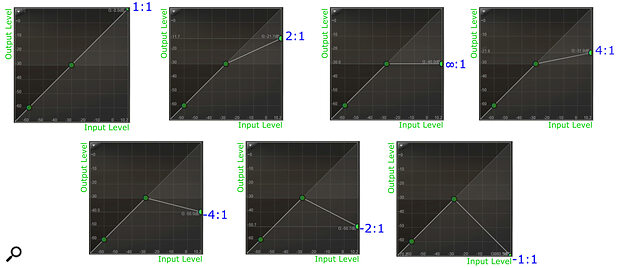 The four diagrams at the top show transfer functions for the common compression ratios 1:1, 2:1, 4:1 and for traditional infinity:1‑ratio limiting. The three diagrams on the bottom row illustrate the much less common negative compression ratios of ‑4:1, ‑2:1 and ‑1:1.
The four diagrams at the top show transfer functions for the common compression ratios 1:1, 2:1, 4:1 and for traditional infinity:1‑ratio limiting. The three diagrams on the bottom row illustrate the much less common negative compression ratios of ‑4:1, ‑2:1 and ‑1:1.
Turn the ratio up, and a compressor becomes a limiter. Go even further and you enter the world of reverse dynamics — and unique sonic effects.
If you’re reading Sound On Sound then I imagine you’re already using compression regularly, so you’ll know that the traditional range of compression ratios stretches from 1:1 (in other words, no compression at all) to infinity:1 (hard limiting). However, even at infinity:1, signal peaks are only limited to the level of the compression threshold — and there are some situations where this can be, if you’ll pardon the pun, a limitation!
For example, let’s say you’ve triggered a snare‑drum sample alongside your live drum kit recording, but you only want to add the sustain phase of the snare sample, not its attack transient or the body of the hit. You could try to use compression to turn down the level of the sample’s onset relative to its sustain, but no matter how high you set the compression ratio, the sample’s sustain is never going to end up any louder than its attack. Even limiting will just put the attack and sustain components at the same level.
Beyond The Limits
As it happens, though, there are a few unusual compressors that offer a solution to this problem by offering negative compression‑ratio settings. To explain how negative compression ratios work, imagine an analogue signal level that measures +12dBu feeding a compressor with its threshold set at 0dBu. At a ratio of 2:1 the signal would be exceeding the threshold by 12dB, so the compressor would apply gain reduction to give an output level only half as far over the compression threshold — in this case 6dB over 0dBu, which means an output level of +6dBu. On the other hand, if you changed the compression ratio to a negative setting of ‑2:1, the compressor’s output level would end up being 6dB below the threshold level, rather than 6dB above it — in other words, 6dB under 0dBu, which would mean an output level of ‑6dBu.
So, if we now return to our previous snare sample scenario, let’s say each hit’s peak level is +12dBu, and you compressed it at a threshold level of ‑12dBu, even the highest traditional compression ratio of infinity:1 would only knock the drum’s attack down to ‑12dBu. With a negative ratio of ‑2:1, however, the attack would be turned down to ‑36dBu, 24dB below the level of the sustain phase — which would remain uncompressed, because it’s below the threshold. With the snare sample’s attack now so far below its sustain in level, mixing it in alongside your live drums would enhance the combined snare sustain much more independently.
Now, to be fair, there are other ways to strip the attack off a simple triggered sample — adjusting the ADSR envelope settings in your sampler, for instance, or applying a slow‑attack gate to the audio. But where I think negative‑ratio compression really comes into its own is as a means of enhancing the sustain of live snare‑drum recordings directly. Here’s what to do.
Processing Live...
You are reading one of the locked Subscribers-only articles from our latest 5 issues.
You've read 30% of this article for free, so to continue reading...
- ✅ Log in - if you have a Subscription you bought from SOS.
- Buy & Download this Single Article in PDF format £1.00 GBP$1.49 USD
For less than the price of a coffee, buy now and immediately download to your computer or smartphone.
- Buy & Download the FULL ISSUE PDF
Our 'full SOS magazine' for smartphone/tablet/computer. More info...
- Buy a DIGITAL subscription (or Print + Digital)
Instantly unlock ALL premium web articles! Visit our ShopStore.

